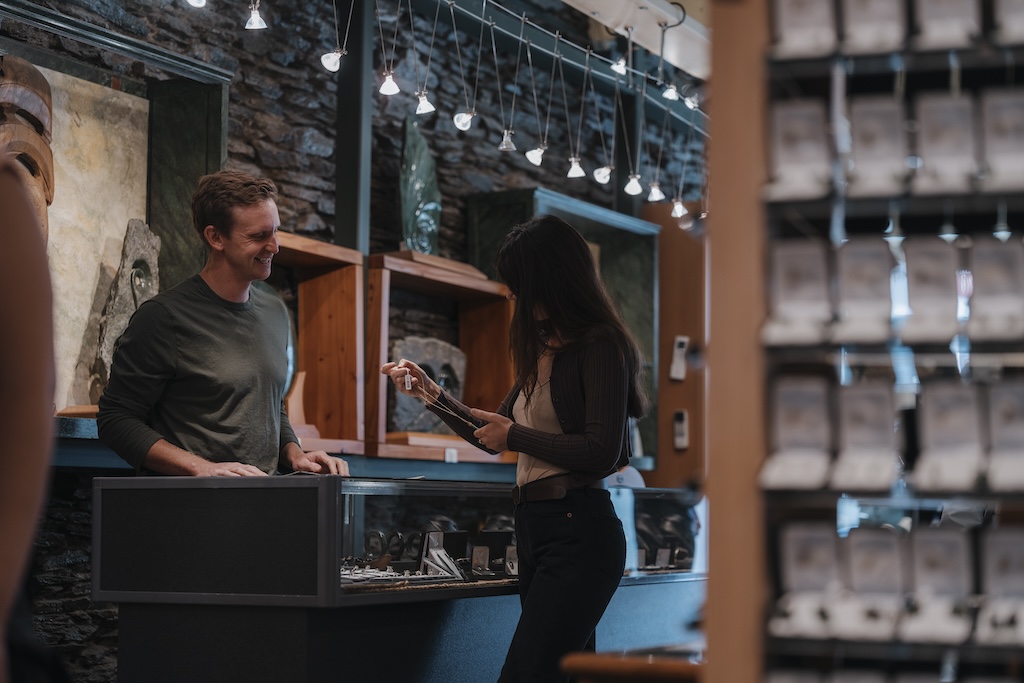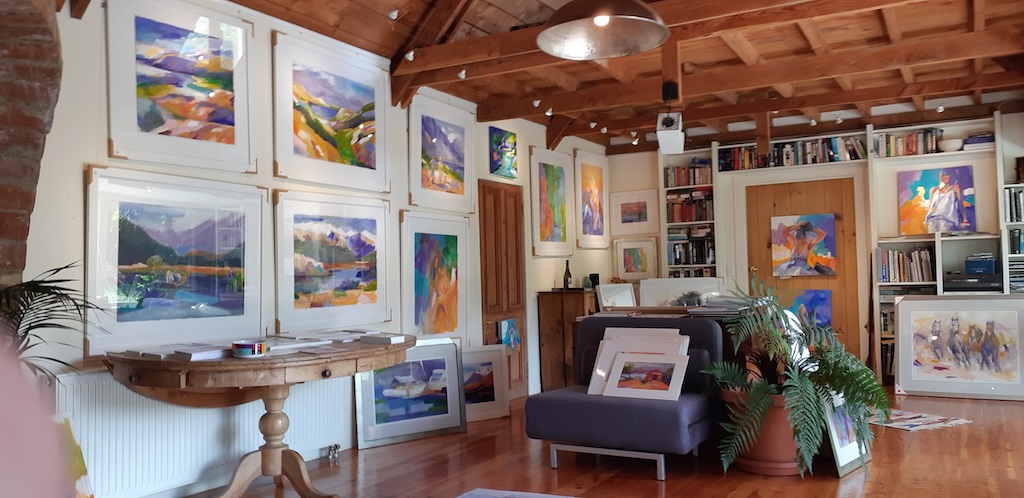More Tourism Like This Please

Camp Glenorchy Eco Retreat’s sustainability goodness nestled at the head of Lake Wakatipu has been beckoning for a couple of years now.
New Zealand’s first Net Positive Energy Retreat and Accommodation opened in early 2018 and was built using green and sustainable design philosophies and materials in line with the international Living Building Challenge. It’s been recognised by the likes of TIME Magazine and punches well above its weight for it’s eco credentials, authenticity and quality.
US philanthropists Debbi and Paul Brainerd are behind the development – the couple has been visiting Glenorchy for over 25 years, and their environmentalism principles are the shining light that makes this property glow.
With a highly photogenic backdrop of surrounding mountains, including fantastic views of Mt Earnslaw, the Richardson and Humboldt Mountains, the luxury eco-friendly camp makes the most of its sunny and protected spot at the town’s entrance.
The Headwaters company runs the property, and managing director Kieran Frost understands the pristine offering under his charge.
He is rightly proud of the extensive facilities that boast luxury cabins, bunk rooms, shared living, dining and kitchen facilities plus the ‘Humboldt Room’ all surrounded by a stunning natural garden setting.
Kieran says that whilst ‘sustainable’ tourism has been the catch cry of the accommodation industry for several years, there is increased focus globally on ‘regenerative’ tourism.
He believes Camp Glenorchy’s intentional eco principles fit right into this movement.
“Regenerative tourism aims not just to do less harm but also restore the impact that the activity might be having on the surrounding area. This is done by offering products designed to give back to the land and the local people which can happen in multiple ways.”
“Here at Camp Glenorchy we are working to create opportunities for our guests so they can truly slow down and experience and appreciate the wider Glenorchy area and be part of our sustainable commitment to this region. It includes the fact that all of the profits from your stay here benefit the Glenorchy Community Trust established to give back and foster resilience in this township.”
The camp’s inaugural Pasture & Pinot Workshop has drawn us here – just one of the first workshops Kieran and his team have developed specifically for Kiwis– an enticing wee staycation. A yoga retreat is planned for November.
The whole Camp Glenorchy team is on hand to offer a warm and genuinely friendly welcome, and we are on a first-name basis from the moment of arrival.
The Pasture & Pinot workshop proves to be an open invitation to drink some of Central Otago’s finest pinot noir and eat the best New Zealand lamb all weekend long. It’s a foodie’s paradise for the attending group of around 25 – many of whom are local Queenstowners, including a happy bunch of ‘art group ladies’.
The two guest hosts are Grant Taylor of Valli Wines and Hannah Miller from A Lady Butcher. After a welcoming morning tea where it feels a privilege to have Camp Glenorchy founders Debbie and Paul Brainerd in the room, we get straight into business with a deep dive into butchery and how to cut up a lamb.
Hannah is from Portland Oregon. After marrying a Kiwi, she is now mixing up her butchery and food skills gained at The Culinary Institute of American, with her love for charcuterie to establish a range of products using New Zealand grass fed lamb, wagyu and local free-range pork.
Her interactive butchery and cooking class is held in Camp Glenorchy’s expansive shared kitchen facility that is decked out with high-end modern equipment, ovens, and cooktops and makes cooking for 25 people look like a breeze.
Before we know it, lunch is served in the adjoining dining room with magnificent views of Mount Earnslaw, and the first Valli wines are being poured to accompany the freshest lamb chops and garden salads.
I am fortunate enough to be seated next to Gant Taylor, who, despite some prodding, manages to stay quiet on the qualities of his intriguing Valli ‘Orange’ pinot Gris served with lunch. The following master wine class held in the stunning Humboldt Room reveals all.
Here we settle in for a couple of hours of Valli wine tasting. It includes their Gibbston Valley, Bendigo and Waitaki pinot.
Grant is a master when it comes to wine growing in Central Otago having been the very first alongside Alan Brady to plant grapes in Gibbston.
He says one of his proudest moments came in 2000 when Gibbston Valley was recognised internationally for its top of the line pinot.
“In 2000 Gibbston Valley received the London International Wine Challenge trophy for the world’s best pinot noir, and that helped put our region on the map. It was fun to be a pioneer in the wine industry back then, and I remember in 1998, which was a great harvest year, we had a young Frenchman out here from Burgundy helping. He felt sorry for us because we didn’t have fathers and grandfathers able to tell us how to make the wine or what to expect from the land like they do in France. But I felt we were so lucky to be the very first people to experience how the grapes grew and reacted in Gibbston, and it was exciting.”
Two hours of wine and food matching flies by. The group sips and samples Valli Wines while Grant explains the finer nuances of growing cooler climate pinot that retains vibrancy and energy. It’s all delicious.
Time to head back to our room, which happens to be one of Camp Glenorchy’s charming Premium Eco Cabin Bedrooms designed to offer luxury comfort with a twist. The rustic décor includes a covered veranda with matching red Adirondack-style loungers, an ensuite with walk-in rain shower, and the most fascinating cabin energy control system run by the touch of a button on the in-room device.
Oh, and the high-end flush less compostable toilet. It’s all totally intriguing!
Simon, our Camp Glenorchy guide, kindly introduced us to the cabin’s intricate eco principles showing how the inner workings are in tune with the entire camp’s eco structure designed around net-positive water and energy consumption.
He told us all accommodation bookings automatically and seamlessly link to the Camps internal operating system.
“Once a bookings allocated, the cabin will identify 24 hours prior that people are coming to stay in it and will automatically start heating up for the exact number of people in the room. That includes preparing just enough hot water for every person to have 7 minutes of hot water for showering per day, so there is no overconsumption of water,” he says.
“There is an air monitor that constantly measures the CO2 in each room and will introduce fresh air as required via an 8-kilometer copper exchange system that is also responsible for the heat exchange – it is very responsive.”
Simon says when people check out of a cabin or luxury bunk hut (of which there are four), the booking system will automatically power the room down, ensuring doors and windows are closed. Guests can view their own cabins’ carbon footprint at the end of a stay to see if they get bragging rights for achieving a low reading.
The camp’s infrastructure and construction materials were all checked against the International Living Future Institutes Red List to avoid hazardous chemicals. The sustainable principles of the Living Building Challenge include Place, Water, Beauty, Equity, Materials, Energy, Health & Happiness, and a representative panel hangs in the shared lounge area to show the meaning of these key elements.
This pure intention is across every level of Camp Glenorchy’s infrastructure, from the buildings’ recycled finishing’s and fittings to the hand-built rock pathways and walls.
Each cabin and building houses a basement underneath where the international Phoenix compostable toilet system quietly goes about its business. It composts using wood chips that overtime transforms the waste into usable fertiliser for the gardens.
There are three beautifully planted wetland areas dotted around the site that facilitates filtering the camp’s greywater while growing some of the largest native plants – think Kowhai, Tussock, and Rock Daisies and Manuka.
Back to the Pinot & Pasture workshop, and after a quick mountain bike around town and up a hill (trying to burn calories), we come together to enjoy Valli Pinot Gris and pre-dinner platters in the Scheelite Campfire Shelter. Everyone has become firm friends, and the following shared style dinner of slow-cooked lamb, cheese, and wine is the perfect way to finish the day.
Sunday morning serves up more blue-sky Glenorchy sunshine alongside A Lady Butchers lamb bacon (there is such a thing), eggs, toast, and coffee to kick things off on the right note.
The workshop culminates with either a trip out to Paradise or an arts and sustainability tour around the camp. I choose the latter and enjoy hearing about the incredible group of local and international artisans, craftspeople and tradies involved in building the camp over several years. From the hand-chosen grey and green wacke rock floors to the beautiful New Zealand art gracing some of the walls – everything is a living breathing testament to the hard work and Debbi and Paul’s philosophies.
The weekend flows like a charm. Before we know it, its bon voyage to the Kieran, Luana, Katherine, and the crew, a quick stop at Mrs Woollies General Store (next door) for freshly made vegetarian pies before heading further up into the Routeburn valley for more mountain biking and sunshine.
It was hard to leave Camp Glenorchy, but it will be very, very easy to come back. Highly recommended.



